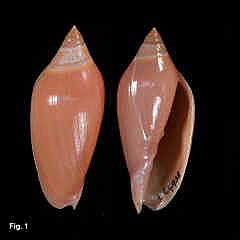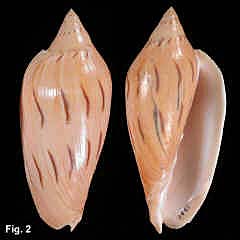|
|
|
|
|
Amoria molleri (Iredale, 1936) Description: Shell smooth, glossy; spire whorls straight sided, body whorl roundly shouldered. Columella with up to 8 plaits, 4 in juvenile shells; posterior plait often developed into a nodule. Outer lip smooth on outer edge but thickened inside aperture for about half its length in mature shells. External colour uniformly orange-pink with a cream line below suture, or with one or two spiral bands of brown stripes. Size: Adults 65-105 mm in length. Distribution: Endemic to Australia; East of Innisfail, central Queensland, to Wollongong, NSW. Habitat: Subtidal, down to 440 metres, but most commonly taken on 100-200 metres. Moderately common. Remarks: This species has a discontinuous distribution over its 2000 km range, with populations varying in shell form and colour. The following subspecies and forms have been recognised by Bail & Limpus (2001): A. molleri molleri (Iredale, 1936) occurs from Cape Moreton, Queensland, to Wollongong, NSW, in 145-180 m. This is the typical uniformly orange-pink shell shown in Fig. 1, although banded forms are found around Cape Moreton. Three further forms of this subpecies - capricornica, reducta and succincta - occur as geographical variants around the Capricorn Channel and Swains Reefs. The capricornica and reducta forms usually have spiral bands of brown stripes (Fig. 2). A. molleri isabelae Bail & Limpus, 2001 has a large, slender shell usually with one or two bands of brown stripes. This occurs in 200-250 m off Hixson Cay. A. molleri vandenbergae Bail & Limpus, 2001 has a smaller but broader, unpatterned shell. It occurs as an isolated population in 300-320 m off Pith Reef, east of Innisfail, Queensland. Fig. 1 Off Barrenjoey Lighthouse, Broken Bay, NSW in 68-73 m (C.064938) Fig. 2 Capricorn Channel, Queensland, in 120 fathoms (219 m) (DLB1951) |

